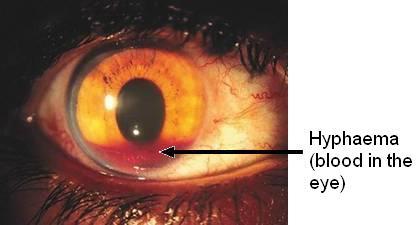Introduction
Eye injury is a common hospital casualty referral. It can result from fight, fall, and chemical exposure, foreign body at work or road traffic accident. It is important for the public and general practitioner to differentiate blunt eye injury from perforating eye injury. The latter may leave the eye with an open wound which can lead rapidly to sight-threatening infection if not referred early.
Blunt eye injury usually results from fist fight, sport injury (badminton or tennis injury). Penetrating eye injury commonly seen in situations such as children injured while playing with sharp object, road traffic accident with shattered windscreen and injury in work place with high velocity flying particles.

Photograph of eye with blunt injury (common during welding and grinding of metal)

Photograph of eye with blunt eye injury

Photograph of eye with penetrating injury (This type of injury needs immediate eye care attention).
Signs & symptom
Blunt eye injury can present as black eye due to skin ecchymosis, painful eye results from corneal abrasion, reduced vision from hyphaema or retina contusion, and double vision due to blow-out fracture.
On the other hand, any displacement of the iris or pupil after injury should alert the possibility of open eye injury and the patient needs immediate referral to eye casualty.
Generally, symptoms such as reduce vision, pain, double vision and others unusual discomfort after eye injury indicate the need of urgent eye care attention.
CAUTION: Any eye injury in children, should be examined by an eye doctor.
Complications
As mentioned above, eye with an open wound need urgent treatment to reduce risk of sight-threatening infection. Some eye injuries can cause cornea infection, cataract, glaucoma or retinal detachment, and delay in treatment may lead to visual impairment.
Treatment
The first line of management for chemical injuries is copious irrigation of the eye with isotonic saline or clean sterile water. In the case of chemical burns, one should not try to buffer the solution, but instead dilute it with copious flushing. Immediate irrigation before reaching hospital or clinic is important to reduce the extent of chemical damage to the eye.
ATTENTION: Eye irrigation should start at the site of accident by using the nearest available clean water such as drinking, mineral or tap water. Irrigation should be done with the injured eye open and the eyeball is move from side to side in order for the irrigation to be even and effective.
Other types of eye injury such as penetrating injury need professional attention and proper surgical management.
Prevention
Prevention is the keyword. Workers in working environment with a possible risk or exposure to eye injury should always wear protective goggles.
| Last reviewed | : | 23 August 2019 |
| Writer | : | Dr. Joseph Vijaya Alagaratnam |
| Reviewer | : | Dr. Rosniza bt. Ab. Razak |







